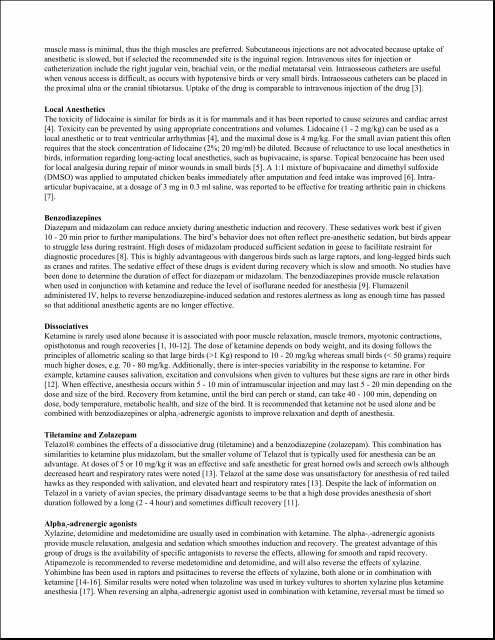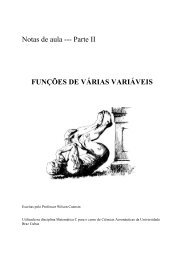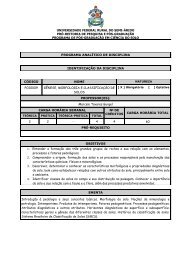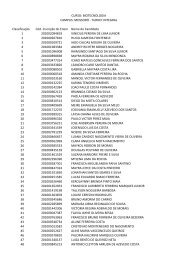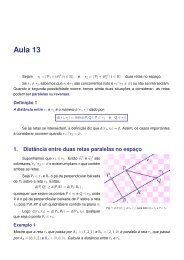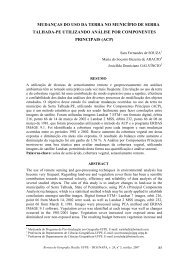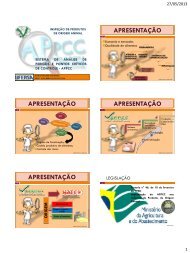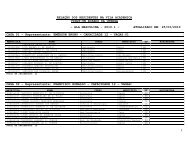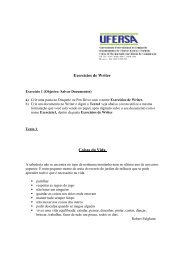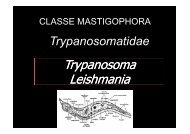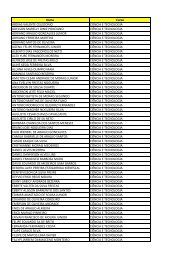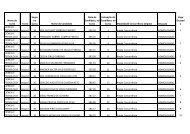Injectable Anesthesia and Analgesia of Birds by J. Paul ... - Ufersa
Injectable Anesthesia and Analgesia of Birds by J. Paul ... - Ufersa
Injectable Anesthesia and Analgesia of Birds by J. Paul ... - Ufersa
Create successful ePaper yourself
Turn your PDF publications into a flip-book with our unique Google optimized e-Paper software.
muscle mass is minimal, thus the thigh muscles are preferred. Subcutaneous injections are not advocated because uptake <strong>of</strong><br />
anesthetic is slowed, but if selected the recommended site is the inguinal region. Intravenous sites for injection or<br />
catheterization include the right jugular vein, brachial vein, or the medial metatarsal vein. Intraosseous catheters are useful<br />
when venous access is difficult, as occurs with hypotensive birds or very small birds. Intraosseous catheters can be placed in<br />
the proximal ulna or the cranial tibiotarsus. Uptake <strong>of</strong> the drug is comparable to intravenous injection <strong>of</strong> the drug [3].<br />
Local Anesthetics<br />
The toxicity <strong>of</strong> lidocaine is similar for birds as it is for mammals <strong>and</strong> it has been reported to cause seizures <strong>and</strong> cardiac arrest<br />
[4]. Toxicity can be prevented <strong>by</strong> using appropriate concentrations <strong>and</strong> volumes. Lidocaine (1 - 2 mg/kg) can be used as a<br />
local anesthetic or to treat ventricular arrhythmias [4], <strong>and</strong> the maximal dose is 4 mg/kg. For the small avian patient this <strong>of</strong>ten<br />
requires that the stock concentration <strong>of</strong> lidocaine (2%; 20 mg/ml) be diluted. Because <strong>of</strong> reluctance to use local anesthetics in<br />
birds, information regarding long-acting local anesthetics, such as bupivacaine, is sparse. Topical benzocaine has been used<br />
for local analgesia during repair <strong>of</strong> minor wounds in small birds [5]. A 1:1 mixture <strong>of</strong> bupivacaine <strong>and</strong> dimethyl sulfoxide<br />
(DMSO) was applied to amputated chicken beaks immediately after amputation <strong>and</strong> feed intake was improved [6]. Intraarticular<br />
bupivacaine, at a dosage <strong>of</strong> 3 mg in 0.3 ml saline, was reported to be effective for treating arthritic pain in chickens<br />
[7].<br />
Benzodiazepines<br />
Diazepam <strong>and</strong> midazolam can reduce anxiety during anesthetic induction <strong>and</strong> recovery. These sedatives work best if given<br />
10 - 20 min prior to further manipulations. The bird’s behavior does not <strong>of</strong>ten reflect pre-anesthetic sedation, but birds appear<br />
to struggle less during restraint. High doses <strong>of</strong> midazolam produced sufficient sedation in geese to facilitate restraint for<br />
diagnostic procedures [8]. This is highly advantageous with dangerous birds such as large raptors, <strong>and</strong> long-legged birds such<br />
as cranes <strong>and</strong> ratites. The sedative effect <strong>of</strong> these drugs is evident during recovery which is slow <strong>and</strong> smooth. No studies have<br />
been done to determine the duration <strong>of</strong> effect for diazepam or midazolam. The benzodiazepines provide muscle relaxation<br />
when used in conjunction with ketamine <strong>and</strong> reduce the level <strong>of</strong> is<strong>of</strong>lurane needed for anesthesia [9]. Flumazenil<br />
administered IV, helps to reverse benzodiazepine-induced sedation <strong>and</strong> restores alertness as long as enough time has passed<br />
so that additional anesthetic agents are no longer effective.<br />
Dissociatives<br />
Ketamine is rarely used alone because it is associated with poor muscle relaxation, muscle tremors, myotonic contractions,<br />
opisthotonus <strong>and</strong> rough recoveries [1, 10-12]. The dose <strong>of</strong> ketamine depends on body weight, <strong>and</strong> its dosing follows the<br />
principles <strong>of</strong> allometric scaling so that large birds (>1 Kg) respond to 10 - 20 mg/kg whereas small birds (< 50 grams) require<br />
much higher doses, e.g. 70 - 80 mg/kg. Additionally, there is inter-species variability in the response to ketamine. For<br />
example, ketamine causes salivation, excitation <strong>and</strong> convulsions when given to vultures but these signs are rare in other birds<br />
[12]. When effective, anesthesia occurs within 5 - 10 min <strong>of</strong> intramuscular injection <strong>and</strong> may last 5 - 20 min depending on the<br />
dose <strong>and</strong> size <strong>of</strong> the bird. Recovery from ketamine, until the bird can perch or st<strong>and</strong>, can take 40 - 100 min, depending on<br />
dose, body temperature, metabolic health, <strong>and</strong> size <strong>of</strong> the bird. It is recommended that ketamine not be used alone <strong>and</strong> be<br />
combined with benzodiazepines or alpha 2<br />
-adrenergic agonists to improve relaxation <strong>and</strong> depth <strong>of</strong> anesthesia.<br />
Tiletamine <strong>and</strong> Zolazepam<br />
Telazol® combines the effects <strong>of</strong> a dissociative drug (tiletamine) <strong>and</strong> a benzodiazepine (zolazepam). This combination has<br />
similarities to ketamine plus midazolam, but the smaller volume <strong>of</strong> Telazol that is typically used for anesthesia can be an<br />
advantage. At doses <strong>of</strong> 5 or 10 mg/kg it was an effective <strong>and</strong> safe anesthetic for great horned owls <strong>and</strong> screech owls although<br />
decreased heart <strong>and</strong> respiratory rates were noted [13]. Telazol at the same dose was unsatisfactory for anesthesia <strong>of</strong> red tailed<br />
hawks as they responded with salivation, <strong>and</strong> elevated heart <strong>and</strong> respiratory rates [13]. Despite the lack <strong>of</strong> information on<br />
Telazol in a variety <strong>of</strong> avian species, the primary disadvantage seems to be that a high dose provides anesthesia <strong>of</strong> short<br />
duration followed <strong>by</strong> a long (2 - 4 hour) <strong>and</strong> sometimes difficult recovery [11].<br />
Alpha 2<br />
-adrenergic agonists<br />
Xylazine, detomidine <strong>and</strong> medetomidine are usually used in combination with ketamine. The alpha- 2<br />
-adrenergic agonists<br />
provide muscle relaxation, analgesia <strong>and</strong> sedation which smoothes induction <strong>and</strong> recovery. The greatest advantage <strong>of</strong> this<br />
group <strong>of</strong> drugs is the availability <strong>of</strong> specific antagonists to reverse the effects, allowing for smooth <strong>and</strong> rapid recovery.<br />
Atipamezole is recommended to reverse medetomidine <strong>and</strong> detomidine, <strong>and</strong> will also reverse the effects <strong>of</strong> xylazine.<br />
Yohimbine has been used in raptors <strong>and</strong> psittacines to reverse the effects <strong>of</strong> xylazine, both alone or in combination with<br />
ketamine [14-16]. Similar results were noted when tolazoline was used in turkey vultures to shorten xylazine plus ketamine<br />
anesthesia [17]. When reversing an alpha 2<br />
-adrenergic agonist used in combination with ketamine, reversal must be timed so


